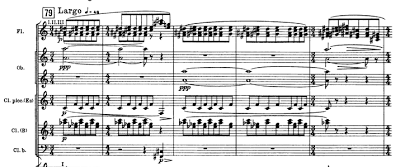There are of course analyses of the Rite, though perhaps not as many as you would think! Stravinsky, in this piece, did not come up with some brilliant new theoretical framework for musical composition the way Schoenberg or Webern or Bartók or Stockhausen did in various pieces. So what did he do and why is this piece so successful?
I think the reasons go contrary to the overarching narrative of 20th century music that we have been taught in so many books: that the 20th century was above all a time of experimentation and technical progress. Yes, it was a time for new ideas: atonality, for new sounds such as the exotic ones Debussy heard at the Paris Universal Exposition in 1889 from a Javanese gamelan orchestra. There are undeniable truths there, of course, but they are not the only truths. While 20th century music did make many innovations, that is not the only narrative.
For 100 years we have been talking about how radically new the Rite was, how the dissonance, the jagged rhythms and the ferocious timbres are what makes it important. But what if that is only a half-truth? What if what makes the Rite a powerful piece of music, greatly admired 100 years later, are different things? After all if it is only the radically new, the dissonance, the jagged rhythms that make the Rite important, then why is it that there are a hundred other pieces, just as radically new, just as dissonant, with rhythms just as jagged that we do not admire, or admire a great deal less?
As every historian knows, you can look at historical events in two ways: in terms of their break with the past or in terms of their continuity with the past. For 100 years we have been looking at the Rite--and all modern music--solely in terms of the radical newness. In doing so, we have been taking our cue from the composers themselves who have been using manifestoes to essentially market their music. Each composer presents themselves as radically new and different as a marketing tool! How much they build on the past is conveniently hidden. And no composer practiced this more successfully than Stravinsky.
We have already seen in the mammoth two volumes by Richard Taruskin, Stravinsky and the Russian Traditions how Stravinsky made use of Russian folk song and other traditions in his music--and fervently denied it! I think we can take a fresh look at the Rite and see some other echoes of previous music.
One of the most important influences seems to be Claude Debussy. Let me choose a couple examples of his music and show how they are reflected in the Rite. One of Debussy's most influential and characteristic pieces is the Prélude à l'après-midi d'un faune, composed in 1894. Here is how it begins:
 |
| Click to enlarge |
Let's listen to the first couple of minutes:
Solo wind, soon accompanied by other instruments in a rhythmically and harmonically ambiguous context. That would also be a pretty good description of the beginning of the Rite:
 |
| Click to enlarge |
Let's listen to that opening:
They almost start with the same note! C# vs C natural in the same octave. I have another example for you. Here is the beginning of another piece by Debussy, "Nuages" from the three Nocturnes for orchestra of 1899:
 |
| Click to enlarge |
And here is a performance:
Now the opening of the second part of the Rite, "The Exalted Sacrifice":
 |
| Click to enlarge |
And a performance:
Not so terribly different, are they?
Of course, the Rite of Spring has much that is quite different from Debussy, but there are certainly echoes of the earlier composer. No composer, not even Stravinsky, springs forth entirely new. Every piece of music builds to some extent on earlier music. Perhaps the most perniciously wrong part of the narrative of 20th century music is that the great revolutionary composers like Schoenberg and Stravinsky created entirely new musical languages. Of course, they did not. Their music is permeated with the gestures of the music of the past. For this reason it is possible for audiences to listen to the music with some degree of understanding and appreciation.
We do not admire the Rite of Spring today because it was written in an entirely new 'private' musical language, but rather because it found new ways of using many older musical ideas and gestures. Like Picasso's use of African masks to discover a deeper aesthetic level, the pounding rhythms of the Rite are not a new musical expression, but rather a very old one.
But I will explore the rhythms of the Rite in another post as this one is already quite long! Let's end with a complete performance of the Rite of Spring:

No comments:
Post a Comment